
Wall of Dignity
In 1967, Detroit experienced one of the most brutal race rebellions in its history. In the early hours of June 23rd, the police raided an after hours club. Expecting to find a few people inside, they instead found 82 individuals. Everyone was arrested and escorted from the building, and as this happened, a crowd of 200 people gathered. As the night slowly crept into the next morning, violence and looting emerged on Twelfth Street, and the Detroit rebellion was underway. The rebellion carried on for five days. Mayor Jerome Cavanagh initially sought to quash the uprising with police units, but failed to gain support for this tactic as many African Americans in the city deemed the police the problem. In 1968, a year after Detroit’s violent rebellion, a local community organizer named Frank Ditto contacted muralists Bill Walker and Eugene Eda Wade, asking them to create a mural in his local community. Wanting to create a mural that could project an expression of black unity during a time of racial pain, Walker and Wade set about creating the Wall of Dignity. Painted on the façade of an abandoned ice-skating rink, the mural was broken down into three main sections. The top half of the mural depicted diasporic scenes of ancient life in Africa, whilst the middle section functioned as a collection of portraits of prominent African American men and women who sacrificed their lives by fighting for black liberation throughout history. The faces of Marcus Garvey, Malcolm X, Martin Luther King Jr., Mary McLeod Bethune and Stokely Carmichael line the wall. The bottom section of the mural, enveloping the words ‘The Wall of Dignity’, depicts scenes of enslavement. Silhouetted figures of manacled men and women stretching their chains taut as they stretch for freedom are countered by figures raising their unshackled hands to the sky in moment of liberty. Towards the left-hand side of the mural, a poem titled ‘Slave Ship’ reads:
I am a prince, speak with respect I shall not be chained to your Bloody deck To live in this filth and stench? Ooooaaee a poor soul have died on his bench This meaning does burst the drums of my ears Long hours from my home seem like years A prince to ear the food of jackals!! My arms, my leg bleed from your shackles You must look to my woman What had been done to one so sweet, so mild? AAAHHH! Within here was my child. Strange tongued-golden haired man I will not journey to your land. Leave me…leave me be… Cast my carcass into the sea The sea.. Black..Black like me.
![Paul Thomas Minnihan, I Dare to Dream, 3353 W 13th St [Black Neighborhood], Chicago, 1995.jpg Paul Thomas Minnihan, I Dare to Dream, 3353 W 13th St [Black Neighborhood], Chicago, 1995.jpg](https://486312.frmmmguz.asia/files/square_thumbnails/b2254bc5fe1b092ee4f9c95af8c1ebf3.jpg)
I Dare to Dream
I Dare To Dream is a Chicago mural painted in 1995 by artist Paul Thomas Minnihan. Drawing heavily upon local history, the mural includes locals such as the Chicago Bulls player Michael Jordan, astronaut and first African American woman to travel into space, Mae C. Jemison, and Harold Washington, the first African American mayor of Chicago. Alongside the Chicago figures are the faces of Mary McLeod Bethune, Frederick Douglass and Martin Luther King Jr. The west side mural was situated opposite the Douglass Branch of the Chicago Public Library, but no longer exists.
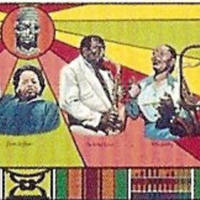
Baltimore Wall of Pride
The Baltimore Wall of Pride stands in the playground at Carey and Cumberland streets in the area of Sandtown-Winchester, Baltimore, Maryland. Painted in 1992 soon after the Rodney King riots of LA, the mural became a site for protest meetings after Freddie Gray was killed in 2015, just blocks away from the mural.Painted by Pontella and Deborah Mason, the mural celebrates the heroes of black history, including Fannie Lou Hamer, James Baldwin, Marcus Garvey, Martin Luther King Jr., Kwame Nkrumah, Charlie Parker, John Coltrane, Langston Hughes, and the antislavery figures Frederick Douglass, Sojourner Truth and Harriet Tubman.
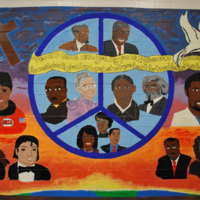
Saint Sabina Mural
In 2011, Chicago-based muralist Lavernon Spivey painted a mural with Howard University students at the Saint Sabina Catholic Church in Chicago’s southside. The mural depicts African American heroes both local and national, past and present, including the antislavery figures Frederick Douglass Harriet Tubman, and also Mae C. Jemison, Barack Obama, Harold Washington, Martin Luther King Jr., Michael Jackson, Michelle Obama, Rosa Parks and Shirley Chisholm. The mural also includes a passage form John 14:27 that reads, “Peace I leave with you, my peace I give unto you not as the world giveth, give I unto you, let not your heart be troubled, neither let it be afraid.”
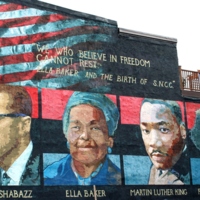
Freedom School
In 2002, with support from the Freedom School Mural Arts Project, Parris Stancell created a mural in West Philadelphia titled Freedom School. The mural sets the faces of Malcolm X, Ella Baker, Martin Luther King Jr., and Frederick Douglass against the backdrop of the American and Black Liberation flags. It depicts Douglass in his younger years, and refers to Malcolm X as Malcolm Shabazz – a composite of his names in the latter years of his life; Malcolm X and el-Hajj Malik el-Shabazz. The mural also champions women's activiism through Ella Baker’s quotation, “We who believe in freedom cannot rest.”
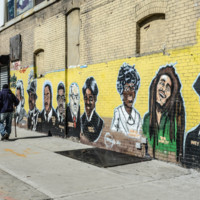
Bed-Stuy Mural
In 2009, the NYC Justice Corps created a mural on Nostrand Avenue and Herkimer Street in Bedford-Stuyvesant, Brooklyn. The NYC Justice Corps was created as part of the city’s strategy to combat poverty and has the mission to “develop the capacity of neighborhoods to address the reintegration challenges of their young adults re-entering from the criminal justice system, and to instil in those young adults a sense of civic responsibility and accountability.”The mural includes the faces of Marcus Garvey, Martin Luther King Jr., Thurgood Marshall, Harriet Tubman, Malcolm X, Shirley Chisholm, Bob Marley and Huey P. Newton, as well as the antislavery figures Harriet Tubman and Frederick Douglass.
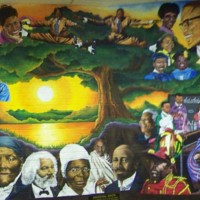
Ancestral Roots
Pontella Mason is one of Baltimore’s unsung visual artists. He has created murals for the Anacostia Community Museum, former President Jimmy Carter, and several other public organisations. His murals depict African American life and the diaspora. In 1999, he created the extensive mural Ancestral Roots, which depicts the antislavery heroes Harriet Tubman, Sojourner Truth, and Frederick Douglass, as well as Martin Luther King Jr., Malcolm X, Muhammad Ali, Notorious B.I.G., Tupac, Shirley Chisholm, and Marcus Garvey.
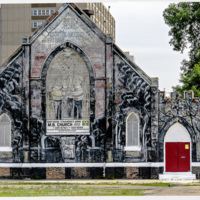
All of Mankind (Why Were They Martyred?)
In 1972, a pioneer of the Chicago mural movement, William Walker, painted a mural on Strangers Home Missionary Baptist Church that was both a rallying call for social justice and a symbol of love and unity. Painted in an era of social revolution, and radical in its day, the inclusionary mural incorporated the names of individuals such as Jesus, Gandhi, Malcolm X, Martin Luther King Jr., and Anne Frank. Further down the murals are the martyrs of the Civil Rights and Black Power movements – names such as Medgar Evers, Mrs. Liuzzo, Fred Hampton, Mark Clark and Emmett Till. In December 2015, All of Mankind was suddenly destroyed. Jon Pounds, executive director of the Chicago Public Art Group (formerly known as the Chicago Mural Group), commented that the mural was a rare remnant of the civil rights era. He knew it was under threat when the church went up for sale in 2011, but preservationists had tried to protect the mural.
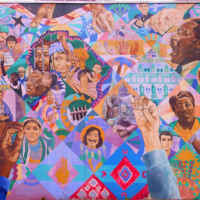
Freedom Quilt Mural
In 1988 David Fichter, with the help of volunteers, painted the Freedom Quilt Mural on the side of the American Friends Service Committee Building in Atlanta, Georgia. The mural was created as part of the Rainbow Coalition events during the 1988 Democratic National Convention. In February 2015 the building, owned by Georgia State University, was torn down – taking the mural with it. The quilted mural is thematically focused on non-violent heroes of history that struggled for justice and peace. It includes the faces of Mubarak Awad, Nelson Mandela, Winnie Mandela, Desmond Tutu, Oscar Romero, Rogoberta Menchu, Leonard Peltier, Andrew Goodman, Fannie Lou Hamer, Daniel Berrigan, Martin Luther King Jr., Rosa Parks, Mahatma Gandhi, and Lucretia Mott. It also includes the antislavery figures of Frederick Douglass and Harriet Tubman. Tubman points towards the North Star. Multi-racial hands stitch the quilt together, joining heroes (both famous and unknown) from all strands of history.
![Anonymous, W Florence & S Western Aves, South-Central LA (Black Neighborhood), 1999 [destroyed].jpg Anonymous, W Florence & S Western Aves, South-Central LA (Black Neighborhood), 1999 [destroyed].jpg](https://486312.frmmmguz.asia/files/square_thumbnails/7fabdee3546a6cb70ee280e97b7dd315.jpg)
Martin Luther King Jr., Malcolm X and Frederick Douglass
This mural of Martin Luther King Jr., Malcolm X and the abolitionist Frederick Douglass appeared in south-central LA in 1999 and had been destoyed by 2010.
![Curtis Lewis, African Amalgamation of Ubiquity, 9980 Gratiot Avenue, Detroit, Michigan, 1985 [destroyed in 2013].jpg Curtis Lewis, African Amalgamation of Ubiquity, 9980 Gratiot Avenue, Detroit, Michigan, 1985 [destroyed in 2013].jpg](https://486312.frmmmguz.asia/files/square_thumbnails/3ac63b31ad894031e7c74b99651ace4a.jpg)
African Amalgamation of Ubiquity
In 1985, muralist Curtis Lewis created a mural on the side of a drug rehabilitation centre on Gratiot Avenue, Detroit, Michigan. The building belonged to Operation Get Down and included the antislavery figures Frederick Douglass and Harriet Tubman, as well as Malcolm X, Mary McLeod Bethune, Jesse Jackson, Thurgood Marshall, Martin Luther King Jr., W.E.B. Du Bois, Booker T. Washington, Ida B. Wells, Marcus Garvey and Nelson Mandela, alongisde Egyptian, Nubian and pharaoh figures. The man who breaks free of his chains in the centre of the mural holds a sign that reads, “Behold my people, arise, stand strong and proud, for ye come from pharaohs, emperors, kings and queens.” The mural was destroyed in 2013.
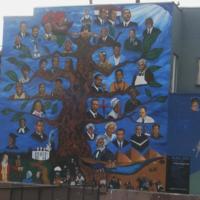
Black Seeds
In 1991, a group of artists – Eddie Orr, David Mosley, William T. Stubbs, Norman Maxwell and Michael McKenzie – collaborated to paint “Black Seeds” on an empty wall in Leslie N. Shaw Park on Jefferson and 3rd Avenue in Los Angeles. The idea for the mural, which appears as an African American tree of life, came from Vietnam veteran and local activist Gus Harris Jr. He recalled how little he learned about African American history in school. He wanted to create a public mural about black individuals who made an important contribution to society.The mural was created under the Social and Public Art Resource Center's 1990-91 “Neigborhood Pride: Great Walls Unlimited” mural program and features the antislavery leaders Harriet Tubman and Frederick Douglass, as well as Booker T. Washington, Thurgood Marshall, Mary McLeod Bethune, Malcolm X, George Washington Carver, Paul Robeson, Stevie Wonder, Shirley Chisholm, Martin Luther King Jr., and Jesse Jackson. The mural was restored by Moses X. Ball to include Barack Obama after 2008. The original canvas upon which the mural was based hangs in Oaks Jr. Market Corner Store at 5th and Jefferson.
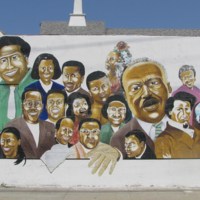
Wings of Faith
In 2005, an anonymous artist painted a mural in Los Angeles that depicted many heroes of African American history. The faces of antislavery leaders Sojourner Truth and Frederick Douglass, alongside Muhammad Ali, Martin Luther King Jr., Malcolm X and Rosa Parks, lined the street. By 2015, the building had fallen into disrepair and the mural had been destroyed.
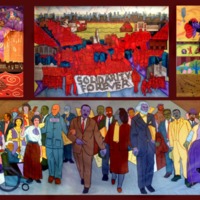
The City at the Crossroads of History
In 2011, the Puffin Foundation commissioned Mike Alewitz to paint a mural for the Puffin Gallery of Social Activism that would be on display in the Museum of the City of New York. Completed in 2014, the mural is a tribute to the labour and social justice movements and contains four panels. It includes slave ships and depicts the antislavery leader Frederick Douglass, as well as Martin Luther King Jr., Coretta Scott King and Elizabeth Gurley Flynn.However after viewing the mural, the museum declined to display it. They requested changes that reduced the prominence of Martin Luther King Jr. and added the Women’s Christian Temperance Union. Alewitz calls this a case of censorship and continues to campaign for his mural to be displayed.
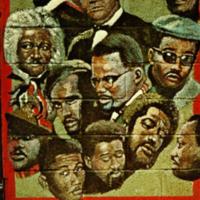
Nation of Islam
In 1990, this mural titled Nation of Islam at Charles Place in Brooklyn was created. The mural unites many radical figures of black history, including the antislavery leader Frederick Douglass, W.E.B. Du Bois, Elijah Muhammad, H. Rap Brown, Malcolm X, Marcus Garvey, Eldridge Cleaver and Bobby Seale. It has now been destroyed.
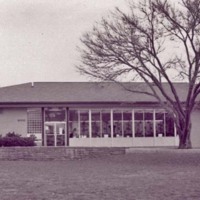
Odom Branch Library Mural
Woodrow Nash created a mural for the Odom Branch Library in the 1970s, depicting the antislavery leader Frederick Douglass alongside Martin Luther King Jr. and Malcolm X. In 1999, the library was remodelled and expanded to around 12,000 square feet. With the expansion came two new murals about black history. The original mural was edited – this time to incorporate the antslavery leader Sojourner Truth. By adding Truth to the mural, Nash was trying to reflect the contribution of women to the liberation struggle.
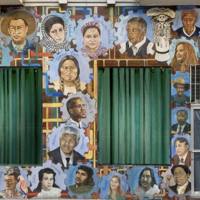
La L.ucha Continua/The Struggle Continues
This mural was painted on 3260 23rd St, between Mission and Capp Streets, in San Francisco by Susan Caruso Green, and was a community collaboration between muralists and local residents. It brings together faces from global history who have fought for civil rights, including the antislavery leader Harriet Tubman, Nelson Mandela, Gandhi, Mumia Abu-Jamal, Malcolm X, and Martin Luther King Jr.
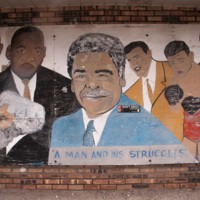
A Man and His Struggles
Titled A Man and His Struggles, this mural by Magic Fingers is in the Oak Park area of Chicago and depicts the first African American mayor of the city, Harold Washington, alongside Martin Luther King Jr., Jesse Jackson, and the antislavery leader Frederick Douglass. In 2016, artists updated the mural, to add the Pan-African flag along its bottom edge.
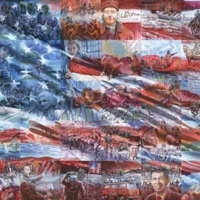
E Pluribus Unum
E Pluribus Unum, “Out of Many, One,” was a mural created by Lewis Lavoie in 2012. Described as a snapshot of America, the mural brings together 50 different stories from American history, celebrating a diverse past. Located in South Jordan City’s central City Hall building, the mural is a collage of narratives such as ‘The Abolitionist Movement,’ ‘the Civil War,’ ‘The Creation of the New Media’ and ‘Westward Expansion’ for example.
![Leroy White, Wall of Respect, Up You Mighty Race, Leffingwell & Franklin Aves, St. Louis MO, 1968 [destroyed 1980s].jpg Leroy White, Wall of Respect, Up You Mighty Race, Leffingwell & Franklin Aves, St. Louis MO, 1968 [destroyed 1980s].jpg](https://486312.frmmmguz.asia/files/square_thumbnails/ccbe25581b885dd6ea7ad25405af90fe.jpg)
Wall of Respect/Up You Mighty Race
In 1968, after the success of Chicago’s Wall of Respect in 1967, muralist Leroy White painted Wall of Respect/Up You Mighty Race in St. Louis, Missouri. The mural was self-sponsored. After seeing Chicago’s Wall of Respect in Ebony, muralists in St. Louis were inspired to create public art in the Carr Square area of the city. The mural was completed by a coalition of individuals from civil rights groups, including CORE, ACTION, and the Zulu 1200s. It displayed a pantheon of black heroes, including the antislavery leaders Frederick Douglass, Malcolm X, Martin Luther King Jr., and Marcus Garvey. The mural quickly became a hub of black activism—bringing together artists, performers and political figures in a series of concerts and rallies at the site. But it was vandalised during the 1970s, and its building was razed in the 1980s.